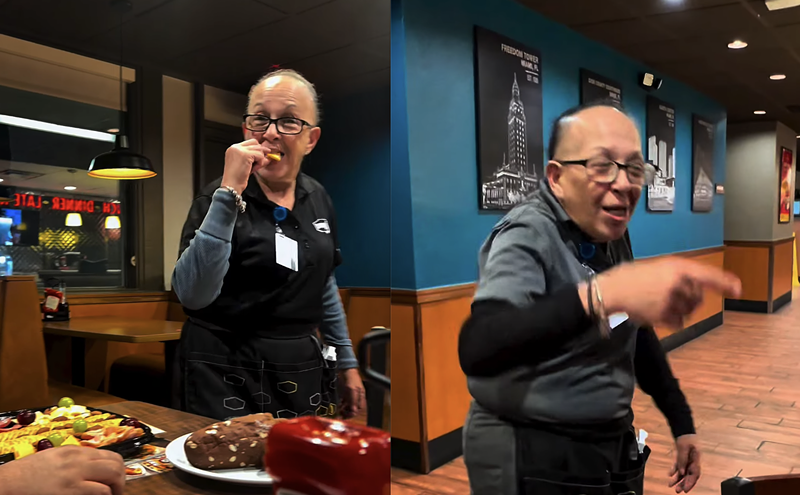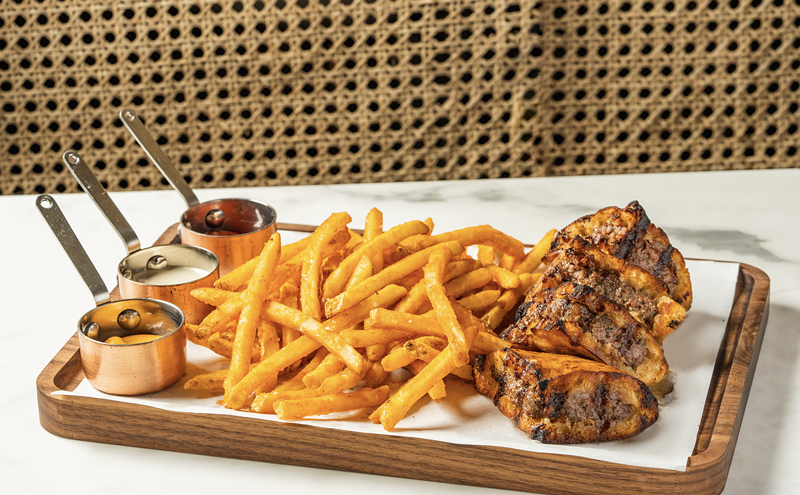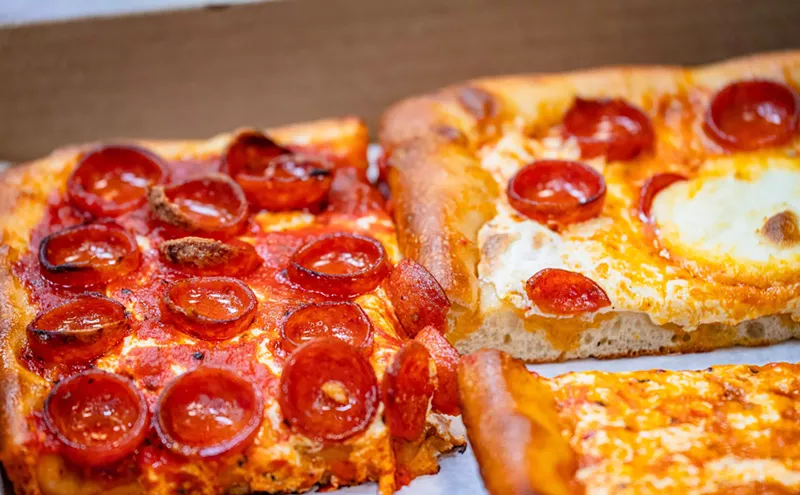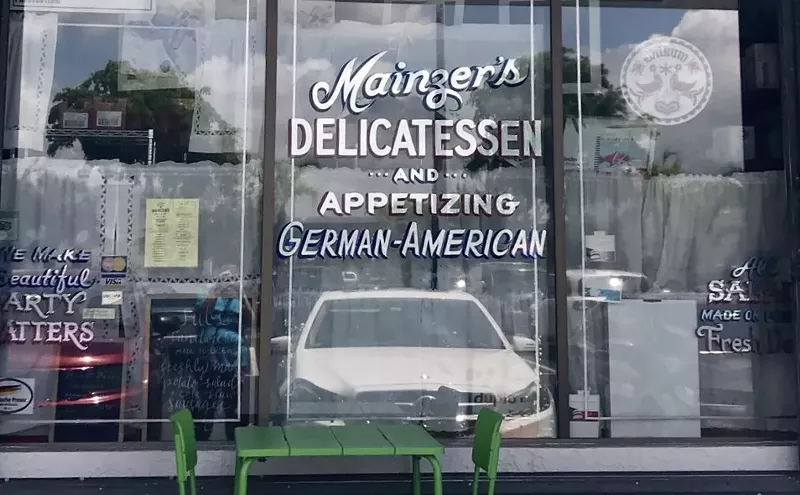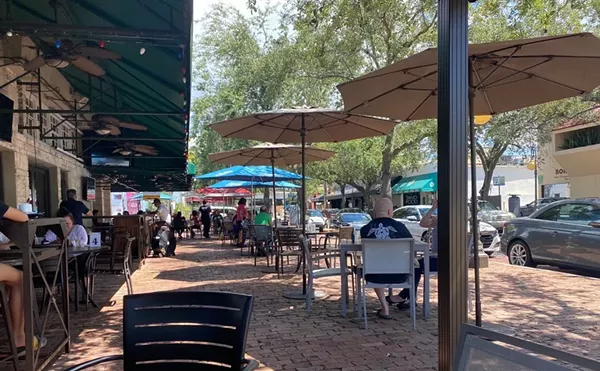It's about 8 o'clock on a sweltering, muggy evening in the parking lot outside the Magic City Casino in Little Havana, and 20 people are in line at the Latin Burger and Taco food truck, where I'm working behind a hot stove. Two dozen other trucks are here, and the area smells like grilled meat.
From the corner of my eye, I spot a bottle blonde with breasts spilling from her casino-issued white button-down shirt. After waiting for about ten minutes, she places her order in a lilting Slavic accent: "Can I have a Latin Macho and an orange soda?"
"Sure," I say as I take her money.
There are already more than a dozen tickets stacked up, but I don't let her know. She stands in front of the window for about ten more minutes and then gets frustrated. "My break is over and I've got to go. I can't wait. I need my money back," she says.
"Hold on a minute," I tell her as I sneak her ticket to the front of the pack. "You're up next, I promise you." Then I offer her a free soda before turning to add cheese, onions, and special sauce onto the meat patty and wrapping the whole thing in foil.
As I hand the casino worker her dinner, I hear grumbling from outside the truck. Then another women asks why her number hasn't been called. She's been waiting for at least ten minutes longer than blondie. Short and wearing a Hurricanes sweatshirt in the 80-degree heat, she looks like a small battering ram.
I remember the raffle tickets the casino provided a few hours earlier and offer her a few along with her meal, which is just coming off the griddle. Then I hand out more tickets to the dozen or so people waiting. "You can win a casino T-shirt or a travel mug," I explain. One by one, everyone gets their burgers and tacos and they are appeased — for now.
These days, Americans spend close to half their disposable income on restaurants and dining out, according to Forbes. Around here, diners range from the rich and famous, who savor an eight-ounce A5 Kobe filet at Prime One Twelve for $240 (sides extra), to college kids, who grab a steak taco for $1.99 at El Taquito in Coconut Grove.
More interesting to me, though, are the people who serve the meals — the waiters, the bussers, and the bartenders. So over the past few months, I observed what really goes on backstage. I shadowed waiters and worked at three restaurants in Miami and Fort Lauderdale plus a food truck. I also talked with dozens of local employees about their jobs, pay, and tips.
At one place I worked, my face and lips swelled like a collagen-injected Real Housewife from the intense heat of the griddles. At another, I watched in wonder as an Italian restaurateur left a $5 tip on a nearly $200 check. A customer at a third eatery fed her Pomeranian bacon from a fork. Some of the workers swore like sailors backstage and then presented themselves like lords and ladies to customers.
But the most interesting thing I noticed is the gross difference in pay between those serving at the brick-and-mortar restaurants and those toiling in the hottest trend on the culinary scene: food trucks. While tips bring old-school waiters as much as $50,000 per year, even in some modest eateries, many food truckers don't earn much more than minimum wage.
Take 35-year-old Steven Korosi, who has worked a little more than a year at the Latin Burger and Taco truck.
He wears many hats, from expediter to manager, yet makes about half what the typical restaurant employee earns. "This is the money that I make. Times are hard," he says, sounding resigned. "I could quite easily be in a worse situation. Though it wouldn't hurt if I had an extra zero at the end of my paycheck."
The Old Fort Lauderdale Breakfast House, or O-B House, in downtown Fort Lauderdale opened in August 2011, but it's already the go-to place for locals who want to linger over a long morning meal. There's no counter service or free Wi-Fi; it has the vibe of a restaurant that's been around for decades. The small standalone building is a Himmarshee landmark. Inside, gold-painted walls are adorned with old prints of World War II seamen. In keeping with the nautical theme, employees wear sailor hats.
A sign in the front reads, "We run a tight ship." That is really the only way owner Rodney Ely can make this small restaurant work. With patrons waiting for a table for more than 45 minutes on weekends, he has to make sure his staff is quick. He has implemented a strict no-substitutions policy with the menu and set other rules for the staff to follow.
The top waiter here is Pete Hardy, who strongly resembles Popeye in his shorts, worker boots, and Greek fisherman's cap. Now in his mid-50s, Pete came to Miami from New Castle, England, in 1982 in search of Fort Lauderdale's legendary beaches and bikinis. Back in the day, he was a punk rocker, but now his Doc Martens are the only remnants of his misspent youth. "We're short a server," he says while naming the special muffins of the day. "Can you bus the tables?"
Shauna Chapman is the only other server on duty this Sunday. Fresh out of a bad relationship, she recently left Boston, the only hometown she's ever known, to return to school in South Florida. Her deep dimples and dark blond ponytail make her look more like a high school girl than the graduate student she is. Shauna is shy but optimistic about her move and new job. "This is the first time I've lived away from Boston, but I'm excited to live somewhere that's warm in the winter," she confides as we prepare napkin rolls for the day.
Breakfast service starts with five Fort Lauderdale firefighters who just got off the night shift. Pete takes their food orders. This is the first of many times today when I'll hear a heated discussion as some guest wants to substitute potatoes for tomatoes ($1 extra) or get a refill on a cup of joe (75 cents). Sure, the no-substitutions rule is handy for the waitstaff and chefs, but it irritates the patrons.
After about 45 minutes, the check comes and the firefighters tip well, about $25 on their $100 check. "Generally the tips are quite generous," Pete says as he sweeps by to pick up the check and the dirty dishes in one graceful move. "No one really gives less than 20 percent."
An older man comes in with a much younger woman. It's difficult to tell whether she's a daughter, niece, or girlfriend. He's dressed in khaki slacks, a black Lacoste polo, and driving loafers. She's wearing a Rolex watch and Dolce & Gabbana sunglasses, which are perched on her shiny, highlighted hair. The man orders coffee and a crab omelet; she goes for a skim latte, an egg white omelet, and a fruit bowl. "Her salon bill is probably more than my rent," Pete quips. For a $40 check, they leave $12. Again, not bad.
A young couple comes in with a toddler and asks for a booster seat. The restaurant has none, so the couple sits the boy between them in a booth. Pete tells me there are no child seats on purpose; kids are messy and they're not really encouraged here. The couple orders eggs and a pancake and asks for a substitute: "Is there anything besides potatoes?" Yes, grits, but not fruit — that's extra. In this little breakfast house, most people go with the flow when they're told they can't get their way.
It's now about 10 a.m. The tables are all filled, and there are almost a dozen names on the waitlist already. Pete and Shauna look less tired than bored. There are four hours to go.
Three retired men walk in and suddenly there's a buzz. Rodney, the owner, says the man in yellow is the former CEO of Roche Pharmaceuticals. With him are two men of the same age, mid-60s. One says he has just returned from the Bahamas, where he loaned his yacht to Columbia Sportswear for a photo shoot. It seems he traded his ship for a day of model-watching. The men are jovial, stay for a while, and leave a decent tip of about $15 for a $54 bill.
We're well into the morning and there's an hourlong wait. Every time a party leaves, the table gets bussed almost immediately. The restaurant plays like a good piece of music. A group that had the foresight to bring their own bloody marys in red plastic party cups sits outside in a makeshift waiting room. At the outside tables, a young couple with a fluffy Pomeranian in a pink T-shirt grows impatient for food. "We're hungry," the man bellows.
I try to diffuse the situation, but the guy follows me inside and angrily extinguishes his cigarette on the window. It could easily escalate, but Rodney calmly asks the man to leave. Maybe he's embarrassed to be seen with a dog in a pink shirt, but he just exits.
The shift is almost over, and two more couples come in. Over cups of coffee, they pass around a grainy black-and-white picture. It's an ultrasound image of one couple's first child. "This is the first naked picture of my daughter," the proud father-to-be says between sips of his latte.
After a seven-hour shift, the checks are tallied up. My split of the tips is $180. That translates to about $25 an hour from grats alone. In Florida, waiters also make a minimum wage of $4.65 per hour from the house. If I were working full-time, that would equal about $55,000 a year — double the salary of an average security guard and nearly equal to that of a low-ranking beat cop.
Pete tells me that he's worked at just about every high-end restaurant in Fort Lauderdale since coming to Florida nearly three decades ago. Though he admits he could make more money working dinner service somewhere else, he considers O-B his place. "It might not be my restaurant, but it's my vision," he says. "I tell Rodney every day: 'It's your money, but it's my restaurant.'"
Then Pete confesses the real reason he's serving breakfast: "Could I make more money at night? Fuck yeah, but then I'd be doing coke, chasing women, and getting into trouble."
Red the Steakhouse is a very special kind of restaurant. It's one of the upscale eateries that have made SoFi — the once-ghetto, now-chichi area south of Fifth Street — the center of the Miami Beach restaurant universe. Executive chef Peter Vauthy takes pride in selling Wagyu steaks that have pedigrees longer than an Oxford graduate's and sell for upward of $20 an ounce. The restaurant's modern décor of dark brown, white, and red blends well with the traditional steak-house service. The ambiance is ideal for dates and business meetings alike.
I'm shadowing Chris Carr, a 26-year-old guy who has made waiting tables his career. He looks like Will Smith from his Fresh Prince days. Tall and thin, he's 90 percent swagger and 10 percent little boy. This place is more precision and less volume. Chris shows me how to dip each preset wineglass into hot water until steam engulfs it, and then wipe it down so there are no smudges from the dishwasher. All silverware must be exactly a thumb's length (from tip to joint) apart.
At 5:30 p.m., the staff gathers for a family meal. It's lasagna — oily, cheesy, and hot, the kind of meal waiters like and hostesses skip. The chef goes over some specials and then notes it's likely the last week of king crab season. But there's still a monster left in the cooler if someone wants to impress a date. One intact crustacean was sold earlier in the week for more than $200.
At 6 p.m., the doors open, but Chris tells me things won't pick up until at least 7:30. He has been with Red since it opened about three years ago. Originally from New Jersey, he moved to Davie to attend Nova Southeastern University. He took a job at a restaurant to make some pocket money and when he heard Red was hiring, he moved to Miami and took a chance on the brand-new steak house, even quitting school against his parents' wishes.
Chris explains the tip-out situation. This is a high-volume, expensive place where a New York strip steak can go for $48. A lot of players dip into the tip pool — 5 percent goes to the bar, 3 percent to the bussers, and 1.5 percent to runners, who help serve the food to patrons. "It doesn't matter," he says. "One big tipper can make the night."
One such tipper is Rosie O'Donnell. A frequent diner, she comes in early with her family and tips generously — sometimes the equivalent of the check. Because dinner for her party can range upward of $500, one visit from O'Donnell or another A-lister pays the rent for the month.
At 7 p.m., the room is still virtually empty. One couple is dining, but not in Chris's section. The music is soft, and a $2,000 Baccarat crystal decanter of Louis Trey cognac sits alone on a cart, lit candles surrounding it like a shrine.
Four men ages 20 to 50 in crumpled suits, looking like they've come straight from a business meeting, are seated at 7 o'clock. Chris takes their cocktail orders and then tells me of the Red waiter's recipe: Take drink orders and water preferences. Six minutes later, describe specials (make sure you've memorized them). Chris talks up the meat: "The steaks are certified Angus Prime. Every one is served at the perfect temperature."
They all order steaks. As they eat, an older couple is seated. They're in from New York. The man is a president at Chase Manhattan Bank. He tells Chris their concierge recommended Red. As the waiter takes drink orders, another couple is seated.
Chris tells me the second couple is on a first date. They're sitting side-by-side on the long banquette. "I suggested they sit that way," Chris says. "I saw them pull up in a McLaren AMG. They're going to tip big. I can feel it." For Chris, this is a game of Monopoly in which the player with the biggest bank at the end of the night wins.
At 8 p.m., a four-top of IBM staffers comes in. There's a clear leader in the group who orders starters for everyone. Two $200 bottles of wine are requested, along with drinks. One man wants a piece of fish, and the leader at the table disapproves. Seafood is a sign of weakness in whatever test this dinner has become.
Chris moves like Gregory Hines, practically tap-dancing from table to table. In fact, his spiel is like a dance. Women are beautiful and are meant to be flattered. Men should be upsold with pitches like "The sommelier just purchased this vintage today, and I'll give it to you for just $125" and "I suggest lobster mac and cheese."
I initially think that approach might be a bit much, but I'm wrong. His gentle but persistent pushing of crab, straight from the Bering Sea to your table in Miami Beach, his insistence that the extra $50 for lobster in the macaroni and cheese is well worth it, are not wasted on this table. He is offered a job at IBM. Chris is excited. I'm certain the offer, like the side dish, will be forgotten tomorrow.
Chris glides across the floor, bidding farewell to the couple from New York and taking a dessert order from the IBM group. This room is his. The bank president and his wife, who did not drink, leave $22 for a $127 check. That's 17 percent, and the check is on the low side. He tells me he'll make it up between the McLaren and IBM tables.
The McLaren date couple leaves. The check is $385, and the tip is $50. That's less than 13 percent, and Chris is disappointed. So far, the night isn't going his way. But it's still early.
The IBMers leave $100 on a $500 check. That's good news. The bad news is that an Italian restaurant owner and his wife on vacation leave $5 on a $162 check.
At 11 p.m., the room drops into an abyss. Though the kitchen is still technically open, the night is over. Chris averages out the tips and figures he'll go home with $150. Not too shabby for three hours of hustling. He says he works as many shifts as he can, and on a busy day, he can make double that amount. Add a few high rollers a month, and Chris can make about $50,000 after taxes.
Though the take-home is almost the same as that at the breakfast joint, there are fewer hours and more downtime. Moreover, Chris uses the connections he makes at the restaurant to further his income stream. "I work with the bouncers at the clubs here in South Beach," he confides. "If there's a group of high rollers at one of my tables and they want to go out, I hook them up. In return, I get taken care of, let's just say."
Juan Carlos Lopez, J.C. for short, is a waiter at GreenStreet, a Coconut Grove brunch joint on Main Highway. J.C. came to the United States from Honduras 25 years ago and began bussing tables at diners. He started at GreenStreet in 1993 and has been working the brunch circuit ever since.
Indeed, J.C. is iconic. Many people are willing to wait to sit at one of his tables, even with the promise of immediate seating elsewhere. "I like what I do. I like to serve people," he says as we wait for the server meeting to begin.
J.C. says he has a twin brother who works at another restaurant. They live together in the Grove. "I can walk to work," he says. "I have enough money to go on vacation and buy nice furniture. I just bought a new flat-screen television. There's nothing better."
Waiting tables is in some ways like being a pediatrician or a teacher: "I serve these families. They come to me. They come to J.C. I've seen babies grow up and even get married. This is my family."
Nancy is one of J.C.'s regulars. Wearing a velour tracksuit and in her mid-50s, she explains she used to live in the Grove but recently moved to New York. After asking J.C. for an omelet and some juice, she says she's here just for the weekend but that she visits GreenStreet and J.C. whenever she gets the chance. Nancy eats quickly and leaves a $15 tip on a $30 check.
Paul and Terry live only a few blocks away and come in every Sunday. When they arrive, J.C. delivers coffee and skim milk without bothering to ask what they want. For them, the familiar is comforting. Why frequent the same place each week? "You always know what you're going to get," Paul says. They leave a $7 tip on a $35 check.
J.C. is 50 years old and doesn't look like he's in great shape, but that's deceptive. He moves faster than servers half his age. For him, this job is the American dream. Working five shifts a week and taking into account a good season, J.C. says he can make $70,000 a year.
He has worked hard at this job, making friends and steady customers. For many patrons, it's not the food that draws them to GreenStreet. It's the people.
I spoke with dozens of guests on a recent morning. There was single refrain when I asked folks why they came: "The restaurant and J.C. are like family."
Latin Burger and Taco, where the Russian beauty made a run for the casino after getting her order, was one of the first food trucks on the Miami scene when it opened two years ago. The rolling eateries have advantages over traditional restaurants: They're mobile, so owners don't have to pay high-priced leases, and workers I spoke with are generally paid just a couple of bucks above minimum wage.
When I began work on the truck this fall, I quickly learned it was far smaller than it appeared from the outside — and much hotter. It didn't help that it was about 89 degrees outside. The griddle and fryer made the truck feel like a small metal box heated to about 350 degrees. I was the fourth person onboard. In the back, Juan Carlos, the prep guy (no relation to the GreenStreet waiter), was preparing dozens of meat patties. Michael, the cook, had the grill fired up, and Steve, the expediter, was ready to show me what to do. I would be taking Steve's place.
I quickly learned to use the cash register and the credit card machine and then was thrown into the fray. At 6:10, I was into my shift. The evening started slowly, thankfully, when a guy in his early 20s with striking blue eyes walked up. As he was waiting for his meal, he told me his name, Doran, and that he's studying to be a chef; he showed me a picture of himself with well-known Miami restaurateur Michelle Bernstein. When I handed him his food, he put three bucks in the tip jar for a $12 check.
Soon, though, a line formed, and by 6:30, I was in the weeds. About ten tickets were lined up over the grill. And it didn't matter how fast I took the orders — things just kept backing up.
How in hell do people at the Cheesecake Factory work with 30-page menus? There was a whole lingo I had to learn for the tickets: Two Latin Macho Burgers, a Burger Beast (a mammoth exercise in mass consumption), and large fries were 2Xmacho, 1BB, 1LF.
When things slowed a bit, a hearing-impaired kid looking a little like Kurt from Glee — young and cute — approached. Clutching an iPhone and a glittery white wallet, he made some hand gestures that let me know he was mute. Then he pointed to his phone. He had typed, "Chicken tomatillo and a side of avocado dressing." Pretty simple. Except I rang it up as a chicken tomatillo taco and not a quesadilla. I got some back talk in sign language. After I rewrote the ticket, he blew me a kiss and showed me his phone, where he'd written, "Thank you you're the best." Then he left two bucks for a $10 order. That equated to a big tip in the food truck game.
"Aren't you hot in there?" a customer asked as she charged $30 worth of food on her Visa card and added a buck for a tip.
"Uh, yes, I am hot." I felt grease embedding every pore of my body. Steve told me that when I got in my car at the end of the shift, I'd really be able to smell just how greasy and meaty I was. The only thing I thought about was a shower. And a gallon of ice water.
At 9:30, the crowd died down considerably. And by 10, we filled out the last ticket of the night. Thank God. We were out of almost everything but burgers. No more chicken tomatillo, fish, Sprite, or Jupiña. This had to be a good night, I thought, because I saw people putting dollars in the tip jar all evening.
As we closed the register, I counted the tips. There was $72.50, including tips from charges. I'd rung up $1,390 for the evening's service. That worked out to about 5 percent in tips, to be divided among four people. We each made less than $20.
Latin Burger's owner, Jim Heins, then walked over, checked out the tips, and pulled $80 from a roll of bills in his pocket. He said he always puts in a little something himself so the guys can go home with at least enough money to fill their cars with gas.
I asked Heins what the guys on the truck make, and he said $8 to $10 per hour, depending on experience. He also noted, with a little headshake, that's before taxes.
As I drove home, I got a whiff of myself and thought two things: My dogs are going to love me, and I need to take a really long shower. But first I had to stop at the nearest Walgreens to buy about ten bottles of ice-cold water.
The next day, I woke up with no aches or pains, which was a good sign. I felt great as I walked into the bathroom. Then I looked in the mirror. My face and chest were bright pink, my eyes were nearly swollen shut, and my lips looked like I'd had collagen injections. It was a reaction to being near the heat from the griddle and fryer all night and a souvenir from working on the truck.
My total wages for the night: $70.62, far less than I had earned at the restaurants.
How do food truck owners find cooks and servers who put up with it?
They hire guys like Steve Korosi — the sometimes-expediter, sometimes-prep guy at Latin Burger — who are thankful for any kind of job.
A year ago, Steve was couch-surfing at a friend's house after his mother died and the construction engineering company she owned closed. He had been working for his mom while taking care of his father, who was diagnosed with dementia, when the bottom dropped out. Suddenly he was left without a job or a home.
"I found out that Latin Burger was hiring, and I've been here since," he says. The position has allowed him to rent an efficiency close to the Metrorail. Steve has a two-year degree in music education from Miami Dade College and hopes to teach one day.
In the meantime, his work might be hot, awful, and poorly paid — even compared to other restaurant jobs — but you won't hear him complaining from the back of the food truck.
"I've gone through a long stretch of tragedies and upheavals. The work at Latin Burger has allowed me to focus on getting by," he says. "Hey, in this economy, I'm just happy to be making any money at all."



